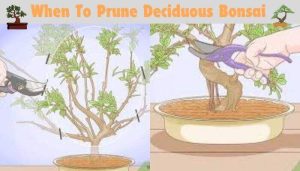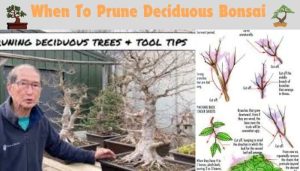When To Prune Deciduous Bonsai – Discover the optimal timing for pruning your deciduous bonsai trees to ensure healthy growth and stunning foliage. Our expert guide will help you achieve the perfect balance between pruning and nurturing your beloved bonsai.
Table of Contents
TogglePrune deciduous bonsai in late winter or early spring before new growth begins. Avoid pruning during active growth periods.
Pruning deciduous bonsai at the right time is crucial for their health and shape. Late winter to early spring is ideal because the tree is still dormant, which minimizes stress and promotes healing. Proper pruning helps maintain the bonsai’s aesthetic form and encourages robust growth.
Always use sharp, clean tools to make precise cuts and prevent disease. Regular pruning also aids in controlling the size and structure of the bonsai, making it easier to manage. Understanding the specific needs of your deciduous bonsai species can further optimize pruning results. Proper timing and technique ensure your bonsai thrives and remains beautiful year-round.
When To Prune Deciduous Bonsai
Prune deciduous bonsai in late winter or early spring before new growth begins. This timing encourages healthy development and maintains the tree’s shape. Regular pruning helps prevent overgrowth and keeps your bonsai thriving.
Deciduous bonsai trees have specific pruning needs. Knowing when to prune them ensures healthy growth and beautiful shapes. The timing depends on the season and the tree’s growth stage.
When To Prune Deciduous Bonsai, Early Spring Pruning
Early spring is an ideal time for pruning. During this period, trees are coming out of dormancy.
- New growth buds: These are just starting to appear.
- Better wound healing: Trees heal faster as they begin growing.
- Shape correction: Easier to see the tree’s structure without leaves.
When To Prune Deciduous Bonsai, Summer Pruning
Summer pruning helps control growth and shape. Focus on removing unwanted shoots.
- Vigorous growth: Cut back new shoots that disrupt the desired shape.
- Light penetration: Remove dense foliage for better light and air circulation.
- Energy direction: Redirect the tree’s energy to more important branches.
When To Prune Deciduous Bonsai, Late Winter Pruning
Late winter is another good time for pruning. Trees are still dormant, but it’s close to the growing season.
This timing minimizes stress on the tree. It also prepares the tree for the active growing months ahead. Pruning in late winter can help maintain the tree’s structure and health.
Avoid Pruning In Autumn
Autumn is not a suitable time for pruning deciduous bonsai. The tree is preparing for dormancy and pruning can harm it.
- Energy storage: Trees are storing energy for winter.
- Increased vulnerability: Pruning can leave open wounds that might not heal properly.
- Risk of infection: Higher chance of infections due to cooler, wetter conditions.

Pruning After Repotting
After repotting, give the tree time to adjust before pruning. The roots need to establish themselves first.
- Recovery period: Allow at least a few weeks for the tree to recover.
- Minimize stress: Avoid adding stress by pruning too soon.
- Better health: Ensures the tree remains healthy and strong.
Pruning your deciduous bonsai at the right time will keep it healthy and beautiful. Pay attention to the seasons and the tree’s growth stage for the best results.
When To Prune Deciduous Bonsai In Winter
Prune deciduous bonsai in late winter before new growth appears. This timing helps shape the tree and promotes healthy development. Ensure tools are sharp and clean to avoid damage.
Pruning deciduous bonsai trees in winter is crucial for their health and aesthetics. Winter provides a unique opportunity to shape your bonsai while ensuring robust growth in the coming spring.
Benefits Of Pruning Deciduous Bonsai In Winter
Winter pruning offers several advantages that are beneficial for your bonsai:
- Dormant State: Trees are less stressed because they are not actively growing.
- Better Visibility: No foliage means you can see the branches clearly and make precise cuts.
- Disease Prevention: Lower temperatures reduce the risk of infections and pests.
When To Prune Deciduous Bonsai, Timing For Winter Pruning
It’s essential to choose the right time for pruning:
- Late Winter: Ideal time, just before the spring growth starts.
- Avoid Frost: Ensure the weather is not too cold to prevent damage.
Tools And Preparation
Having the right tools and preparing adequately is crucial for successful pruning. Here are some tips:
- Sharp Pruners: Use well-maintained, sharp tools for clean cuts.
- Sanitize Tools: Disinfect tools to prevent the spread of disease.
- Plan Cuts: Visualize the shape you want before making any cuts.
When To Prune Deciduous Bonsai, Techniques For Effective Pruning
Different techniques can help achieve the best results:
- Structural Pruning: Focus on removing large branches to shape the tree.
- Maintenance Pruning: Trim smaller branches to maintain the desired form.
- Cut at Angles: Make cuts at a slight angle to encourage healing.
Post-pruning Care
After pruning, it’s important to care for your bonsai properly:
- Watering: Keep the soil slightly moist but not waterlogged.
- Protection: Shield the tree from extreme temperatures and wind.
- Monitor Growth: Regularly check for any signs of disease or stress.
By following these guidelines, your deciduous bonsai will thrive and maintain its beauty throughout the year.
When To Start Pruning Bonsai From Seed
Prune deciduous bonsai from seed in early spring before new growth emerges. This timing promotes healthy development and structure. Regular pruning helps maintain the desired shape and encourages vigorous growth.
Growing bonsai from seed is a rewarding journey. It requires patience, knowledge, and the right timing for pruning. Let’s dive into when to start pruning your deciduous bonsai from seed.
Understanding The Growth Stages
Before pruning, it’s crucial to understand the growth stages of your bonsai. Each stage requires different care.
- Seedling Stage: This is when the plant is in its infancy. It needs time to develop roots and a strong base.
- Sapling Stage: The bonsai begins to develop branches and leaves. This is when it starts to take shape.
- Mature Stage: The tree is more established. It’s ready for more structured pruning to refine its appearance.
Initial Pruning
Initial pruning is essential for shaping and guiding the growth of your bonsai. Here are key points to consider:
- Timing: Start initial pruning when the sapling has a few sets of leaves.
- Tools: Use sharp, clean scissors to avoid damaging the plant.
- Technique: Prune the top growth to encourage root development and thicker trunk.
When To Prune Deciduous Bonsai, Seasonal Considerations
Pruning at the right time of year ensures healthy growth. Different seasons impact how and when you should prune.
- Spring: Ideal for pruning as the tree is in its growth phase.
- Summer: Light pruning can help maintain shape.
- Autumn: Focus on removing dead or unhealthy branches.
- Winter: Avoid heavy pruning to prevent stress on the tree.

Frequency Of Pruning
The frequency of pruning depends on the growth rate and desired shape of your bonsai. Here’s a brief overview:
- Young Trees: Prune more frequently to shape the trunk and primary branches.
- Mature Trees: Prune less often but more strategically to refine the structure.
- Dormant Periods: Reduce pruning to allow the tree to rest and recover.
Tools And Techniques
Using the right tools and techniques is vital for effective pruning. Consider the following:
- Bonsai Scissors: Essential for precise cuts.
- Concave Cutters: Useful for removing branches without leaving stubs.
- Wiring: Helps guide branch growth and shape.
By understanding these aspects, you can ensure your deciduous bonsai thrives from seed to maturity.
Bonsai Pruning Diagram
Prune deciduous bonsai during late winter or early spring before new growth appears. This timing ensures healthy development and optimal shaping. Avoid pruning in late autumn to prevent stress on the tree.
Bonsai pruning can seem like a delicate task, but a clear diagram can make it easier. Visual aids offer invaluable guidance on where and how to trim your deciduous bonsai for optimal growth and aesthetics.
Key Elements Of A
Understanding the basic components of a pruning diagram ensures effective pruning. Here are the key elements to look for:
- Primary branches: These are the main structural branches of your bonsai.
- Secondary branches: These grow from the primary branches and add volume.
- Tertiary branches: These are smaller branches that provide finer details.
- Pruning points: Specific spots where you should make cuts.
- Growth direction: Arrows indicating where new growth should be encouraged.
Benefits Of Using A Pruning Diagram
Bonsai pruning diagrams offer several advantages, making the pruning process straightforward and effective.
- Visual guidance: Provides a clear picture of where to cut.
- Precision: Ensures accurate and effective trimming.
- Efficiency: Saves time by eliminating guesswork.
- Confidence: Helps you prune with assurance.
How To Interpret A Bonsai Pruning Diagram
Deciphering a pruning diagram might seem complex at first. However, a few tips can help you make sense of it:
- Look for symbols: Different icons indicate various types of cuts.
- Follow arrows: They show the direction of desired growth.
- Note the colors: Different colors may signify primary, secondary, or tertiary branches.

Tips For Effective Pruning Using A Diagram
Proper interpretation of your pruning diagram ensures a successful pruning session. Here are some tips to get you started:
- Study the diagram: Familiarize yourself with all elements before starting.
- Use the right tools: Sharp, clean tools make precise cuts.
- Be patient: Take your time to avoid mistakes.
- Monitor progress: Regularly check the diagram as you prune.
A well-crafted bonsai pruning diagram can be your best friend in maintaining a healthy and beautiful bonsai. Use these insights to make the most out of your pruning efforts.
How To Prune A Bonsai Tree
Prune deciduous bonsai trees in early spring before new growth appears. Focus on removing dead or overgrown branches. This encourages healthy development and maintains the tree’s shape.
Pruning deciduous bonsai trees is both an art and a science. Proper pruning enhances their beauty and promotes healthy growth. Mastering the technique requires understanding when and how to prune effectively.
Understanding The Basics Of Pruning | When To Prune Deciduous Bonsai
Pruning a bonsai tree involves cutting away certain parts to shape and promote growth. It’s essential to know the tree’s needs:
- Type of bonsai: Different species require different pruning techniques.
- Growth stage: Younger trees need different care compared to mature ones.
- Seasonal timing: Prune at the correct season to avoid damaging the tree.
Tools Needed For Pruning
Using the right tools makes the process easier and more effective. Here are some essential tools:
- Pruning shears: For precise cuts.
- Concave cutters: To remove branches without leaving a stub.
- Wire cutters: For shaping and training the tree.
- Tweezers: To remove small leaves and debris.
Steps To Prune Your Bonsai
Follow these steps to prune your bonsai tree correctly:
- Examine the tree: Identify which branches need to be pruned.
- Remove dead branches: Cut away any dead or unhealthy branches.
- Trim overgrown branches: Keep the tree’s shape and size in check.
- Thin out crowded areas: Allow light and air to reach the inner branches.
- Refine the shape: Cut back to a pair of leaves to encourage bushier growth.
Tips For Successful Pruning | When To Prune Deciduous Bonsai
Pruning isn’t just about cutting; it’s about knowing when and how to do it right. Follow these tips:
- Use sharp tools: Clean cuts heal faster and reduce the risk of disease.
- Angle your cuts: Make cuts at a slight angle to prevent water from pooling.
- Know the tree’s growth pattern: Understand where new growth will appear.
- Be patient: Avoid over-pruning, which can stress the tree.

Common Mistakes To Avoid
Many beginners make mistakes that can harm their bonsai. Here are common pitfalls:
- Over-pruning: Removing too much foliage can weaken the tree.
- Pruning at the wrong time: Each species has an ideal pruning season.
- Using dull tools: This can crush branches and cause damage.
- Ignoring aftercare: Proper care after pruning is crucial for recovery.
By following these guidelines and tips, you can ensure your deciduous bonsai tree thrives and maintains its beautiful form.
When To Start Pruning Bonsai? | When To Prune Deciduous Bonsai?
Prune deciduous bonsai during late winter or early spring before new growth begins. This timing encourages healthy development and shapes the tree effectively.
Pruning deciduous bonsai can seem daunting, but with the right timing, your tree will thrive. Understanding when to start pruning is crucial for maintaining a healthy and beautiful bonsai.
Early Spring Pruning
Early spring is an ideal time for the first pruning of the year. Here’s why:
- Dormant Stage: The tree is still in its dormant stage, making it less stressful.
- Bud Visibility: Buds are easier to see, helping you make precise cuts.
- Growth Preparation: Prepares the tree for vigorous spring growth.
Late Spring Pruning
Late spring offers another opportunity to prune. This period is beneficial for different reasons:
- New Growth: Fresh growth can be shaped and controlled.
- Health Check: Identify and remove any damaged or diseased branches.
- Sunlight: Ensure even sunlight distribution by thinning out dense areas.
Summer Pruning
Summer pruning helps maintain the shape and health of your bonsai. It’s a great time for:
- Control Growth: Manage the rapid summer growth and maintain the desired shape.
- Air Circulation: Improve air circulation within the canopy.
- Sun Protection: Prevent sunburn by thinning out leaves, allowing filtered light.
Early Fall Pruning
Early fall is another key period for pruning deciduous bonsai. Here’s what to focus on:
- Post-Growth: The tree has completed its growing season, making it easier to shape.
- Prepare for Dormancy: Helps the tree prepare for its dormant winter stage.
- Structural Pruning: Focus on structural pruning to enhance the tree’s form.
When To Prune Deciduous Bonsai, video!
Winter Pruning
Winter pruning is less common but can be beneficial under certain circumstances. Consider:
- Dormancy: The tree is fully dormant, reducing stress from pruning.
- Structural Visibility: With no leaves, the branch structure is clearly visible.
- Disease Management: Remove any remaining diseased or dead branches.
Understanding these key periods for pruning will help you maintain a healthy and aesthetically pleasing deciduous bonsai.

Frequently Asked Questions
When Is The Best Time To Prune Deciduous Bonsai?
The ideal time to prune deciduous bonsai is late winter or early spring. This period ensures minimal stress on the tree. Pruning during dormancy promotes healthier growth.
How Often Should I Prune My Deciduous Bonsai?
Prune your deciduous bonsai once a year. Annual pruning keeps the tree healthy and maintains its shape. Regular pruning also encourages new growth.
Can I Prune Deciduous Bonsai In Summer?
Pruning deciduous bonsai in summer is not recommended. Summer pruning can stress the tree. It’s best to prune in late winter or early spring.
What Tools Are Needed For Pruning Bonsai?
Essential tools for pruning bonsai include sharp scissors, branch cutters, and concave cutters. Using the right tools ensures clean cuts. Clean cuts promote faster healing.
Conclusion
Pruning deciduous bonsai at the right time ensures healthy growth and stunning aesthetics. Aim for late winter to early spring. Regular maintenance helps maintain shape and vigor. Always use sharp tools to prevent damage.
Following these tips will help your bonsai thrive and flourish beautifully.
